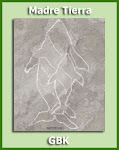By Raúl C. Álvarez.
2001, Montreal, Canada
There is a man, an artist whose canvas is the land. A beautiful land that he says "…it is next to paradise". It is an arid zone, with golden sand, a clear blue sky, under the extreme heat. Baja California, a dry peninsula surrounded by sea. It is there where ancient peoples painted in the stone walls more than 5,000 years ago, the expression of their art.
It is there too where --partially inspired by these ancient cave paintings--, Francisco Gerardo Hernández Zamora uses the land as the canvas for his huge creations called "GEOGLIFOS", writing on the earth; painting the face of the earth... literally.
 Over one thousand kilometers south of the US-Mexico border, in the middle of the peninsula, state of Baja California Sur, next to the San Ignacio Lagoon, the artist drew on the land a sketch of huge proportions --
Over one thousand kilometers south of the US-Mexico border, in the middle of the peninsula, state of Baja California Sur, next to the San Ignacio Lagoon, the artist drew on the land a sketch of huge proportions --
The "Laguna San Ignacio" is one of four gray whale breeding sites where they arrive at the end of their winter migration from the Alaskan and Canadian shores. Until recently an endangered species, the gray whales’ population has grown to as many as that at the end of the XIX century, when the species began to decrease due to over hunting. This growth has been achieved after the strong measures taken for decades to protect the species.
The monumental project represents --among many other ideas— "…an homage to the gray whale for surviving to the human species, and an homage to the later for learning to respect the other" says Francisco Hernández. The homage extends to the "Almeja Catarina", a clam species which has also been overexploited in the shores of the Lagoon and is one of many other endangered species of the region. This is a symbol, a reminder of what can happen to many other species from the lagoon and ultimately, from any other ecosystem in the earth.
But Francisco’s work was not of an artist alone. It was the collective of the community of San Ignacio, a community of fishermen where people work also in the ecotourism industry for whale watching. It was the work of many children too who particiapted in the project, and of the friends that came to help and participate from other places from the peninsula and beyond. They all shared the experience of creating a monumental message to the world, a message about respecting the land where we all live, about the need of a respectful relationship with the environment, and about promoting alternative technologies for socio-economic and cultural development. All this summarized in his personal thesis of the art like an axis of social development.
The magnitude of this work of art made the community proud of themselves and resulted in an impressive awareness of their power of creation as a collective: "…any social task that wants to be pursued, independently of its size, is doable if there is will, compromise, effort and collective creativity to make it happen." The soul of any community is mighty and this desert is a good place to make it flourish.
And certainly Francisco made it flourish. In March 21st., 2002, after 3 years of intense work, Hernández Zamora, together with the community of San Ignacio, will officially inaugurate the "Geoglifo de
But "Kuyimá" is not the beginning, and certainly not the end of the story. This is a sequel of Francisco’s first project, the "Geoglifo de
After Kuyimá following is another ambitious project, with an even more ambitious and significant message: the "Geoglifo de










No hay comentarios:
Publicar un comentario